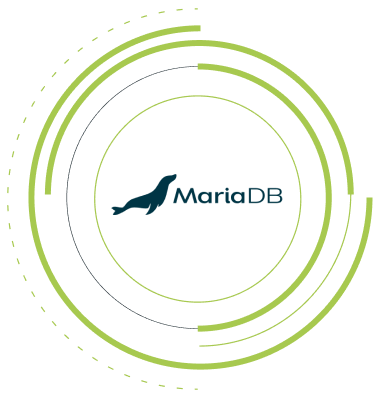Case studies
TRUSTED BY TEAMS AROUND THE WORLD

“Better quality assurance and stability of critical enterprise features are extremely compelling. At our scale and in production with 100,000 MariaDB databases, reliability is what matters most.”
– SVP of Development and Operations, ServiceNow
25 Billion
The ServiceNow cloud platform handles 25B queries per hour powered by MariaDB.
100,000
The number of MariaDB databases in production to support the ServiceNow cloud platform.
Why make the switch
From MySQL to MariaDB: A Smarter, Freer Future

The Difference Between Choice and Vendor Lock-in
MySQL and MariaDB are both open source relational databases with comparable structure and functionality. But because Oracle owns MySQL, many users find themselves on a fast track to vendor lock-in with other proprietary solutions, such as Oracle Cloud and Oracle Heatwave. By contrast, MariaDB prioritizes flexibility and freedom for users. Our open source relational database started as a fork of MySQL and maintains protocol compatibility with MySQL. Our database experts – including the original core MySQL team – bring the best of database technology without vendor lock-in.

Jump ship before MySQL requires more product lock-in
After MySQL 5.7 reached end of life in October 2023, version 8.0 introduced deeper Oracle integration and limited third-party compatibility. MariaDB offers a smooth, risk-free migration path without vendor constraints.
- Maintains MySQL protocol compatibility with no application changes needed
- Zero learning curve — your team keeps using the tools they already know
- Flexible, cloud-native deployments across private, public, or hybrid environments
Ready to upgrade to MariaDB?
CONTACT SALES 

Your information is secure with us
a partner you can trust
How MariaDB Carries the Torch of Open Source Database Innovation

Faster innovation
MariaDB has an active open-source community under GNU/GPL licenses, with quarterly GA releases and a once a year LTS version of the community edition.
.svg)
The M in LAMP
MariaDB Server performs many of the same functions as MySQL while constantly innovating on new features. As a result, our database solution is commonly recognized as the “M” in the LAMP stack.

Billion+ downloads
MariaDB Server has been downloaded over one billion times, proving its ease of use, adaptability, and strong resilience worldwide.

Default in Linux distributions
MariaDB Server replaced MySQL as the default database in major Linux distributions such as Debian, RHEL, CentOS, openSUSE, and Fedora.

Pluggable storage engines
Unlike MySQL, MariaDB Server’s extensible architecture supports multiple storage engines, letting users optimize for various workloads and use cases.
Ready to upgrade to MariaDB?
CONTACT SALES 

Your information is secure with us
a partner you can trust
6 Ways to Do More with MariaDB
1
Oracle Database compatibility
MariaDB supports Oracle data types, sequences,
and PL/SQL, enabling seamless “lift and shift” migrations without rewriting schemas or procedures.
3
Columnar storage format
MariaDB supports row and columnar storage for hybrid workloads, enabling real-time transactions and ad hoc analytics in a single platform.
5
Temporal tables
MariaDB supports bitemporal tables, enabling point-in-time queries and allowing DBAs to audit or recover data after changes occur.

2
High availability and scalability
Ensure continuous availability with zero-interruption failover, transaction replay, parallel query, read replication, and multi-master clustering for seamless scaling.
4
Vector embedded search
Implement retrieval-augmented generation (RAG) to build AI applications that deliver accurate and contextually rich results, eliminating the complexity of integrating multiple databases.
6
JSON functionality
MariaDB supports JSON-formatted data, allowing users to seamlessly combine structured and semi-structured data for more flexible application development.
Ready to upgrade to MariaDB?
CONTACT SALES 

Your information is secure with us
MariaDB vs. MySQL
SMARTER CHOICE. STRONGER RESULTS.
Feature
MongoDB-compatible API
Columnar storage
Temporal tables
Oracle database compatibility
Non-blocking backups
Transaction replay
Secure by default
Vector Embedded Search









MySQL








faqs
FREQUENTLY ASKED QUESTIONS
Find the answers you need right here.
MySQL 5.7 became EOL in October 2023. As such, users need to
decide if they want to stay with MySQL 8.0 and progress to Oracle products such as Oracle Cloud and Oracle Heatwave.
Alternatively, businesses can consider switching to a different open source database that offers more flexibility.
Users cannot downgrade from MySQL 8 to 5.7. If users aren’t satisfied with MySQL 8, they must switch to another open source database.
MariaDB started as a MySQL fork and uses the same wire protocol and SQL dialect, making the migration from MySQL to MariaDB relatively
straightforward. MariaDB’s team of data experts offers an easy guide to migration for businesses to follow.
Our global clients
 24/7 Expert Support
24/7 Expert Support Zero-Downtime Upgrades
Zero-Downtime Upgrades Built for Mission-Critical Workloads
Built for Mission-Critical Workloads Up to 8 Years of Maintenance Assurance
Up to 8 Years of Maintenance Assurance 24/7 Expert Support
24/7 Expert Support Zero-Downtime Upgrades
Zero-Downtime Upgrades Built for Mission-Critical Workloads
Built for Mission-Critical Workloads Up to 8 Years of Maintenance Assurance
Up to 8 Years of Maintenance AssuranceReady to Make the Switch?
Get a tailored evaluation, hands-on guidance, and peace of mind from day one.
 True open source
True open source
 MySQL compatible for easy migration
MySQL compatible for easy migration
 Better performance
Better performance
 24/7 Expert Support
24/7 Expert Support Zero-Downtime Upgrades
Zero-Downtime Upgrades Built for Mission-Critical Workloads
Built for Mission-Critical Workloads Up to 8 Years of Maintenance Assurance
Up to 8 Years of Maintenance Assurance




.svg)


.svg)